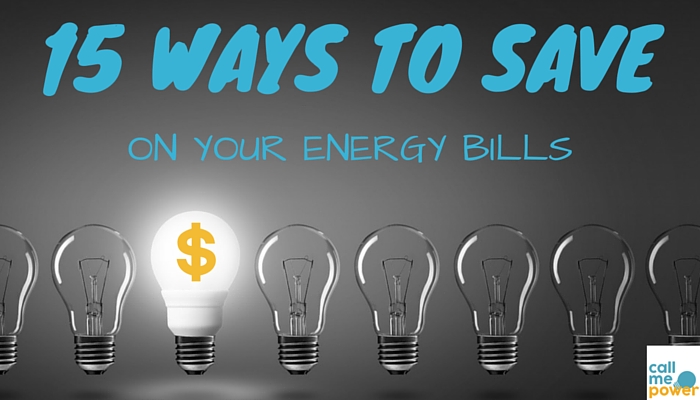15 Awesome Ideas for Saving Money on Your Energy Bills
In 2012, Americans spent an average of $750 per person per year on energy - and that number is only increasing year by year! Here are 15 ways to trim your bill by saving energy at home.

Did you know? Depending on where you live in the US, you may be able to find cheaper rates with an alternative energy supplier. Call us at phone currently not available to find out more about your energy options.
Seven Ways to Save for Free
Not Using It? Turn It Off!
Sure, leaving a lightbulb on when you're not in the room here and there might only amount to a few pennies lost, but this can add up quickly over the course of the year. Despite what some people might say, it doesn't take up more energy to start a light than it does to keep it running, so it's better to get into the make it a habit to turn off lights when you leave a room.
Unplug It
When it's off, it's off, right? Unfortunately for your energy bills, many electronic appliances run on standby mode, even when you've turned them off. This vampire energy can account for as much as 10 percent of a home's electricity usage. Unplug electronics such as your laptop, radio, or television when you're not using them, or consider plugging them into a power strip that you can switch off to save time.
Practice Some Patience
Whether it's winter and your home feels like an icebox or summer and your home feels like an oven, try to resist the urge to crank up the heat or A/C to a higher or lower temperature than what you actually desire. Setting your heating/air conditioning to a hotter or colder temperature than what you actually need to feel comfortable isn't going to make the system work any faster. Instead, you're more likely to waste energy reaching a higher/lower temperature than necessary when you forget to reset it later. So if it's winter and you're waiting for the house to heat up, put on an extra sweater or scarf while you wait, or consider cooling down with a fan or damp cloth if the house is feeling hot and stuffy in the summer.
Give Your Clothes a Cold Shower
Did you know up to 90 percent of the energy used by a washing machine goes towards heating the water? Washing your clothes in cold water can have a considerable (positive) impact on your energy bills, and is gentler on your clothes as well. Today here are many cold-water detergents available, so you can rest assured that your clothes will come out as clean and fresh as with hot water.
Give Your Appliances Some TLC
Don't forget your appliances when spring cleaning! Keeping them clean and running smoothly will keep then running efficiently and for longer, saving you money along the way. For your fridge, this means cleaning the coils at the back of it and defrosting your freezer. Cleaning dust off the coils of your fridge two to three times a year can reduce energy consumption by up to 6 percent, and frost should be removed when it builds up to 1/4" or more. Similarly, cleaning out the ducts of your clothes dryer at least twice a year will keep it from running harder than it has to.
Dress Seasonally
If you're wearing Tshirts in January or sweaters in July, chances are you're paying for more energy than you should be. Try to keep the temperatures indoors as close as possible to temperatures outside. Dress warmly in the winter and cooly in the summer
Did You Know?Every degree over 68°F leads to a 1 percent increase in heating energy costs from the difference in temperature between indoors and outdoors.
Pay a Cheaper Rate
Depending on where you live in the US, you may have the possibility of purchasing your electricity or gas from an alternate supplier instead of from your local utility. Alternate suppliers can offer a wide variety of energy and rate options, and you may find a good deal for your energy. Call us at phone currently not available to find the best rates available in your area.
Two Ways to Save That Require a Bit of Cash
Switch to LED or CFL
Compared to traditional incandescent bulbs, compact fluorescent lamps (CFL) are four times more efficient and use 50-80 percent less energy. They may cost a little bit more than a traditional bulb, but over the long run will save you money, as they generally use about one-third the amount of electricity to run and can up to 10 times longer. For example, single 18-watt CFL replacing a 75 watt incandescent will save about 570 kWh over the course of its lifetime - 10 cents per kWh, that's equivalent to saving $57!
Install a Programmable Thermostat
Your temperature needs change depending on the time of day, so keeping the house a constant temperature usually means that you're using more energy than you need to. For example, allowing the temperature to change by 10 degrees Fahrenheit (cooler in the winter, or hotter in the summer) overnight over the course of the year can save 10-15 percent in heating/cooling costs. Purchasing and installing a programmable thermostat is relatively easy, and will go far in the long run in terms of delivering you savings.
Six Investments That Pay Off in the Long Run
Get a Home Energy Audit
You may decide to do a home energy audit yourself to save some money, or choose to call in the help of a professional for the most accurate results. Either way, it's a good idea to dedicate some time (and a corresponding budget) to examining how much energy your home consumes, and what changes can be made to improve its efficiency. You may choose to make any one of the following changes to reduce how much energy your home uses.
Upgrade Insulation
Ensuring that your home is properly insulated can lead to saving up to 40 percent on heating and cooling bills, and improves comfort in your home. Important spots to look out for include:
- The attic
- Ducts (if located in an unconditioned space)
- Cathedral ceilings
- Exterior walls
- Flooring
New Windows
Did you know that windows can account for 10 to 25 percent of your heating bill by letting heat out? Consider replacing old windows with new, high-performance windows, which will improve your home's energy performance by allowing less heat to be lost or gained.
Replace Old Appliances With Energy Star-Grade Models
The Energy STAR label indicates appliances that achieve premium levels of energy efficiency, based on standards set by the US Environmental Protection Agency (EPA). Energy STAR-certified products are generally 10-15 percent more efficient than standard models on the market. This may translate to a slight price premium, but any additional purchasing costs will be more than made up with energy savings in the long run.
Consider Home Solar
One way to lower your energy costs is to reduce the amount you purchase from the grid entirely. Home solar technology is becoming more affordable, and the time required to pay off installation is reducing rapidly. Check out our article about community solar to find out more about the possibilities of solar power for your home.
Consider Switching to Natural Gas
In most states, natural gas is a cheaper source of fuel than electricity. So if you're renovating your home and don't have a gas line to your home, consider contacting your local utility about natural gas connection. Natural gas can be used to fuel home space heating, water heating, cooking appliances, and can even be used for running a clothes dryer. Depending on what sources of electricity are used you live, switching to natural gas may even lower your carbon footprint.
